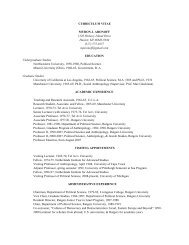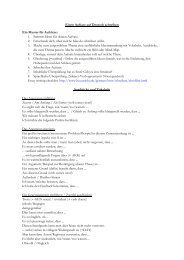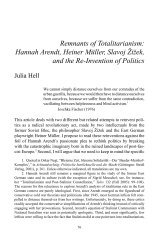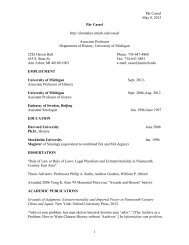Making History Personal: Constantine Cavafy and the Rise of Rome
Making History Personal: Constantine Cavafy and the Rise of Rome
Making History Personal: Constantine Cavafy and the Rise of Rome
Create successful ePaper yourself
Turn your PDF publications into a flip-book with our unique Google optimized e-Paper software.
Frier, “<strong>Making</strong> <strong>History</strong> <strong>Personal</strong>,” page 6<br />
The rise <strong>of</strong> <strong>Rome</strong> was, from this perspective, an unexpected but successful attack by <strong>the</strong> peri-<br />
phery on <strong>the</strong> center, with a resulting cartwheel in <strong>the</strong> political balance <strong>of</strong> <strong>the</strong> world. However, it<br />
was <strong>and</strong> is far from clear that <strong>the</strong> cultural imbalance was similarly upended by Roman conquest.<br />
<strong>Cavafy</strong> continued actively experimenting with his ancient materials: emphatic pro-<br />
Hellenism statements like “Epitaph” (1893), “Sculptor from Tyana” (first draft 1893), <strong>and</strong> “The<br />
Glory <strong>of</strong> <strong>the</strong> Ptolemies” (first draft 1896); <strong>and</strong> generalized warnings against political hubris like<br />
“Darius” (first draft 1897?), “Theodotus” (before 1911), <strong>and</strong> “Ides <strong>of</strong> March” (1906). However,<br />
arguably it is only in <strong>the</strong> first decade <strong>of</strong> <strong>the</strong> new century that <strong>Cavafy</strong> found his own distinctive<br />
“historical” voices, in poems like “Orophernes” (1904), “Poseidonians” (1906), <strong>and</strong> “The End <strong>of</strong><br />
Antony” (1907); <strong>and</strong> especially from 1910 onward (as <strong>Cavafy</strong> neared 50), <strong>the</strong>se voices <strong>the</strong>n<br />
emerged in <strong>the</strong>ir fully mature form with justly famous poems such as “The God Ab<strong>and</strong>ons Antony”<br />
(1910), “Maker <strong>of</strong> Wine Bowls” (first draft 1903; final version 1912), <strong>and</strong> “Alex<strong>and</strong>rian<br />
Kings” (1912). 20<br />
By this date, “The Glory <strong>of</strong> <strong>the</strong> Ptolemies” (its final version dates to 1911) had doubtless<br />
acquired, in <strong>Cavafy</strong>’s mind, a decidedly ironic resonance. Indeed, he had transformed his fundamental<br />
viewpoint entirely: no longer <strong>the</strong> culture clash between <strong>the</strong> Hellenistic world <strong>and</strong><br />
<strong>Rome</strong>, but ra<strong>the</strong>r, far more prominently <strong>and</strong> problematically, <strong>the</strong> clash <strong>of</strong> politics, diplomacy, <strong>and</strong><br />
war, <strong>and</strong> <strong>the</strong>ir immediate harsh consequences for morale in <strong>the</strong> Hellenistic East. From about<br />
1900 until <strong>the</strong> end <strong>of</strong> his life in 1933, he would write <strong>and</strong> publish or circulate some 40 poems<br />
concerned in one way or ano<strong>the</strong>r with <strong>the</strong> political ascent <strong>of</strong> <strong>Rome</strong> in <strong>the</strong> Mediterranean. While<br />
21<br />
<strong>the</strong>se poems hardly constitute a formal cycle, <strong>the</strong>y do demonstrate his deep <strong>and</strong> unflagging interest<br />
in <strong>the</strong> subject.<br />
When <strong>the</strong>se poems are rearranged in <strong>the</strong> chronological order <strong>of</strong> <strong>the</strong> events <strong>the</strong>y describe,<br />
<strong>the</strong>y tell a grim story <strong>of</strong> seemingly inexorable conquest. The world <strong>of</strong> <strong>the</strong> great Hellenistic kings<br />
was, at <strong>the</strong> outset, both supremely self-confident <strong>and</strong> averse to sacrifice or making hard choices:<br />
largely results from <strong>the</strong> poem’s dramatic date <strong>and</strong> its atmosphere <strong>of</strong> complacency—a different issue. See Pinchin,<br />
Alex<strong>and</strong>ria Still (1977) 40-42.<br />
20<br />
On <strong>Cavafy</strong>’s artistic development in this crucial period, see esp. Anton, Poetry <strong>and</strong> Poetics (1995); Mendelsohn,<br />
Collected Poems (2009) xxvi-xxxvi.<br />
21<br />
They were described as a cycle by Yourcenar, “Critical Introduction” (1939/1980) 166-167. Vassilios Lambropoulos<br />
suggests to me that <strong>the</strong>y are better described as a cluster or constellation or field <strong>of</strong> inter-related poems, or<br />
even better (following Gilles Deleuze) as a loose-knit “assemblage.”
















